Single National Minimum Wage
Overview
* In the global landscape of labor laws and wage regulations, the concept of a single national minimum wage-one uniform wage rate applicable to all workers regardless of industry, region, or occupation-has been adopted by several countries. This approach aims to simplify wage structures, reduce inequalities, and ensure a basic standard of living for all workers. Here are some examples of countries that have implemented a single national minimum wage (ref. Post #150).
Country US $ per hour
Australia 18.12
New Zealand 16.42
United Kingdom 15.67
Germany 15.16
France 14.05
South Korea 10.90
* Australia…is renowned for its comprehensive wage regulation system. The Fair Work Commission annually reviews and sets the national minimum wage, applicable to all employees who aren’t covered by specific awards or agreements.
* New Zealand…New Zealand’s Employment Relations Act establishes a single minimum wage rate for all workers regardless of industry or region. There are also provisions for starting-out and training wages, but the primary rate applies universally to adult workers.
* United Kingdom…has implemented a National Living Wage, which serves as the minimum wage for workers aged 23 and over. Younger workers and apprentices have different rates, yet the National Living Wage ensures a base level of income for the majority of adult workers.
*Germany…introduced a statutory minimum wage known as the Mindestiohn, in 2015. This wage applies universally across all sectors and regions, with periodic adjustments.
* France…maintains a single national minimum wage known as the SMIC (Salarie Minimum Interprofessionel de Croissance). Reviewed annually, the SMIC ensures all workers receive a minimum income regardless of their profession.
* South Korea…enforces a single national minimum wage, which is reviewed and adjusted annually by the Minimum Wage Commission.
* The United States’ system of a Federal Minimum Wage, a State Minimum Wage, and a Tip Credit (a correction factor that helps states meet both Federal and State Minimum Wage requirements) is dysfunctional. The Tip Credit has been subject to numerous controversies and legal challenges. Critics argue that it can lead to wage theft and exploitation, particularly if employers fail to comply with legal requirements.
NO COMMON SENSE
ANALYZE THE EXAMPLE
* Which supports and barriers were in play?
* What were the dynamics?
* Who, or what, won the Tug-of-War?
* Discuss the outcome with your friends and family.
* Use Post #4 as a reference for the relationships and dynamics between supports and barriers.
